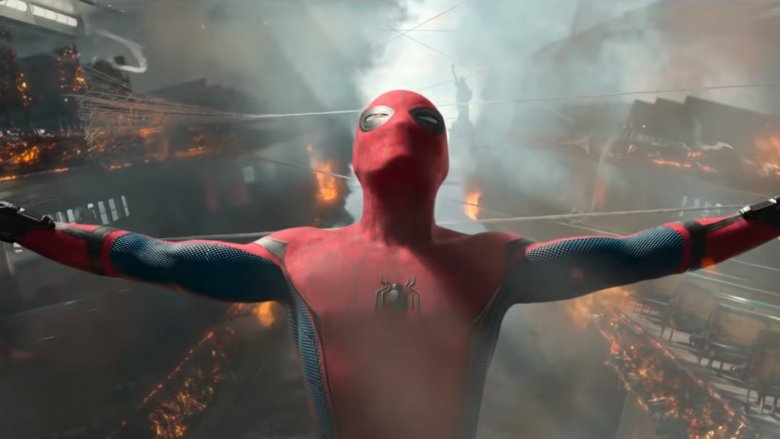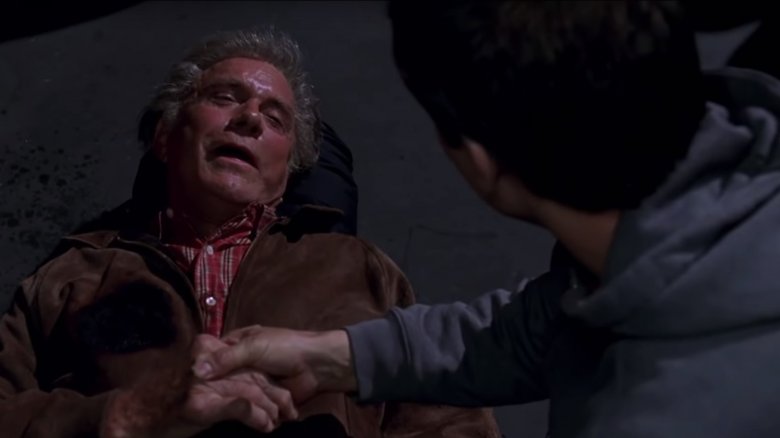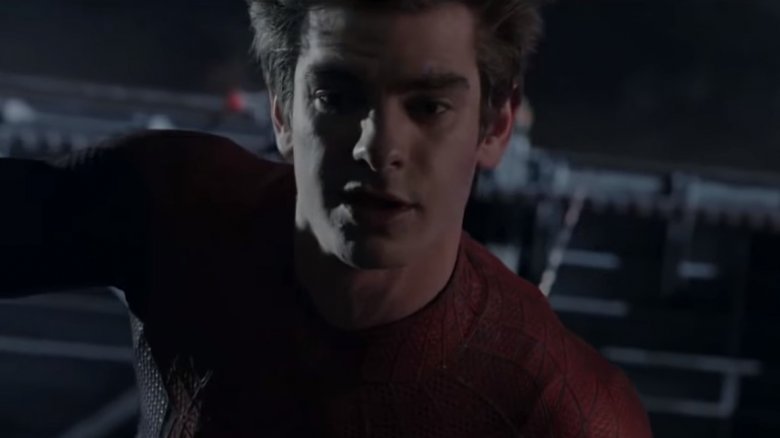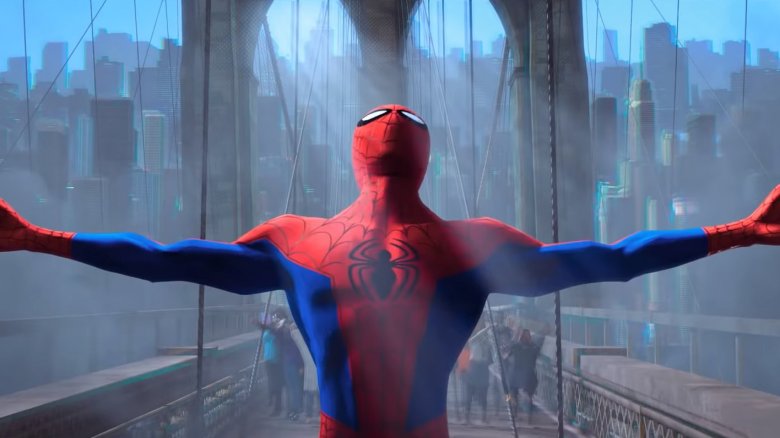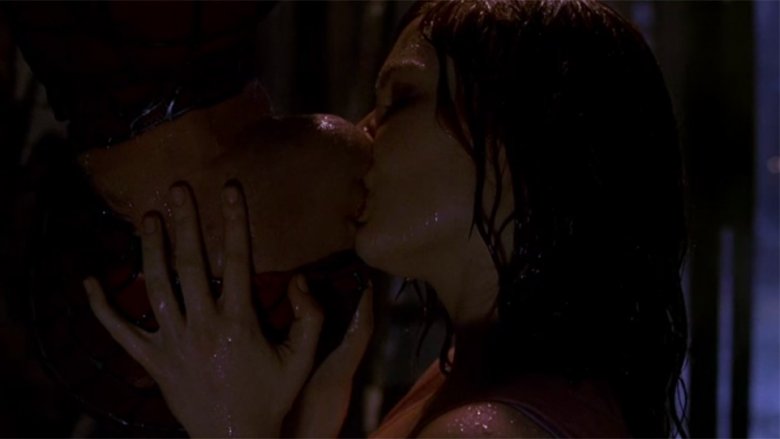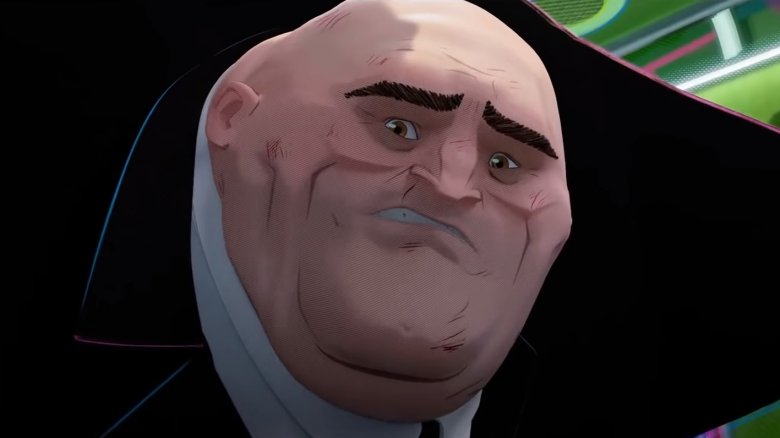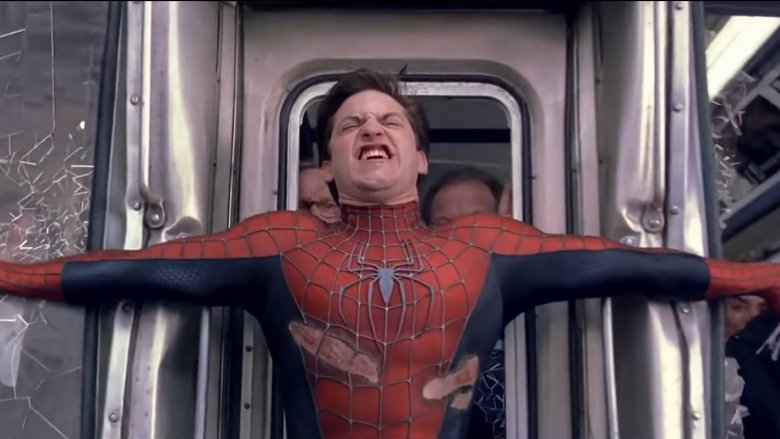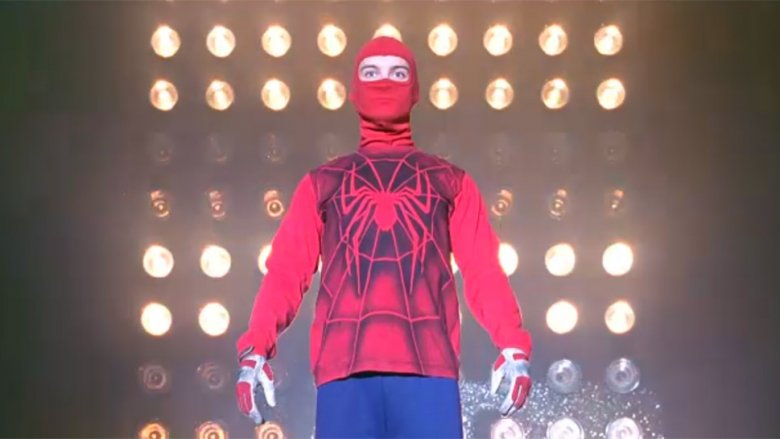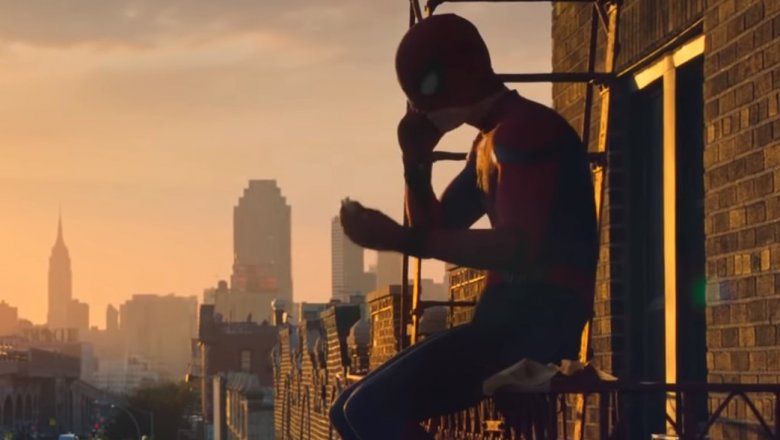These Things Happen In Every Single Spider-Man Movie
Spider-Man, Spider-Man, does whatever a spider can... assuming that particular spider is a big enough pop culture icon to carry seven feature films, with an eighth on the way and no sign of slowing down any time soon. He's easily one of the world's most beloved superheroes, with thousands of comic books that can allow filmmakers to draw inspiration and give audiences something new every time.
And yet, the Spidey films that we've gotten in theaters tend to hit the same elements over and over again. On one level, that makes sense; those seven films represent four completely different versions of the Spider-Man story, and every re-telling of a legendary character like Spidey should keep stuff that's worked for the past 60 years. On the other hand, well, it sometimes feels like you could go to the theater with a checklist (or, if you're old enough, a drinking game) and have more fun with that than you could with the movie. Here are the things that feel like they happen in every single Spider-Man movie.
Say goodbye to your uncle, kid
Let's start with a gimme here: if you have a nephew or niece, and you find out they've been bitten by a radioactive spider and developed fantastic abilities like sticking to walls or proportionate strength, pack your bags and get out of town as fast as you can. Otherwise, you're headed for disaster. We've seen poor Ben Parker get murdered for the sake of an ironic lesson about power and responsibility almost as often as we've seen Dom Toretto talk about family.
Admittedly, it's the most important part of Spider-Man's origin story — even more important than the spider, when you get right down to it — and if we're being fair, there aren't a whole lot of Spider-Man comics that go by without some mention of Uncle Ben, either. Still, you have to admit that watching an old man get shot starts to lose its impact when you've seen it that often. The Sam Raimi Spidey trilogy is especially egregious in this regard, with Uncle Ben's murder happening in Spider-Man, a flashback to it in Spider-Man 2, and a completely different version of the murder that involves the sad-sack movie version of the Sandman forming a huge chunk of the plot of Spider-Man 3.
It should probably be noted that this tendency towards avunculicide (your new word of the day) isn't limited to Ben. In Spider-Man: Into the Spider-Verse, Miles Morales watches as his own uncle is murdered in front of him. And while the MCU has avoided even a mention of the late Ben Parker so far — with only a couple oblique references in Captain America: Civil War and Spider-Man: Homecoming — Far From Home is going to take place in the aftermath of Tony Stark's death. He's definitely not Peter's uncle, but if ever there was someone who fit the "weird uncle" archetype in Peter's life, it's that guy.
Mask? What mask?
One of the most interesting choices in Spider-Man's design is that he's one of the few American superheroes whose costume leaves him completely covered from head to toe. His mask doesn't even have a mouth, just a pair of big, teardrop-shaped eyes meant to convey his emotions. This works pretty well in comics, but in movies, where actors use their faces to, y'know, act, it presents a problem. That's probably why, in movies, Spider-Man seems like he'll do whatever he can to get out of that mask, secret identity be damned.
Again, the Raimi trilogy is the biggest offender in this regard — not only does Peter's mask get shredded by villains with a frequency that makes you wonder just how many spares he has laying around, he'll occasionally just take the whole thing off. Again, it's a lot easier to tell a character's struggling when you can see their face, but eventually, people are going to wonder why everyone has seen Spider-Man's face except the guy whose job it is to take photographs of him.
Along the same lines, Homecoming features a recreation of the famous scene pulled from Amazing Spider-Man #33, where Spidey fights his way out from underneath tons of rubble, refusing to give up while he still has people to save. In the comic, all of the "acting" is handled by body language, but on the big screen, Tom Holland's Spidey takes his mask off to get some fresh air and keeps it off so that we can see him powering through his superheroic feat of strength. Andrew Garfield's Peter Parker does the same in Amazing Spider-Man to help calm down a boy who's in danger. As for Spider-Verse, well, Peter (B.) Parker spends most of the movie unmasked and in sweatpants.
Crucifixion imagery
There are very few things that superhero movies love as much as crucifixion imagery. You might recall the scene in Man of Steel, for instance, where our hero's ghostly space father tells the son he sent to Earth that he can "save" everyone, prompting Superman to stick his arms out and start hovering in a pose that's pretty familiar to anyone who's ever been inside a church. While that's the least subtle example, Spider-Man's movies are as full of it as anything else.
That's probably to be expected considering that the Spider-Man saga is the story of a very human hero who has great power and a great responsibility that always requires him to sacrifice something in order to save people. But once you start noticing it, you'll find it happens a lot. Spidey stopping the train in Spider-Man 2 is the most obvious instance, but there's also the scene where Peter tries to hold the ferry together in Homecoming, a pretty similar shot.
Surprisingly, while it comes close with the death of Gwen Stacy, the two Amazing movies manage to avoid this one for the most part. Meanwhile, Into the Spider-Verse might make up for it by featuring some good ol' fashioned Christ imagery twice in the first two minutes of the film. One is, of course, a recreation of the Spider-Man 2 train scene, and the second is a similar setup with cars falling off of opposite sides of a bridge. That one, just in case you thought we were reading a little too much into things, is the one where Spidey is bathed in rays of sunlight that give him just a tiny bit of a halo effect. C'mon, you've seen that movie. You know they knew what they were doing in every single frame.
A complicated love life
One of the most compelling parts of Spider-Man's story is the impact that his superheroic career has on his soap operatic love life. It's the source of endless drama, and it usually gets pretty complicated. The same goes for the movies — every single Spider-Man film has a love story right there at the core of its plot, with all the twists and turns that you'd expect.
In the Raimi films, it was Peter's on-again, off-again relationship with Mary Jane Watson, which starts out complicated and only gets more tangled as the films continue, especially with Gwen Stacy (and a pretty clingy alien symbiote) being introduced in Spider-Man 3. In Amazing, Gwen was free of a love triangle, but that relationship was complicated by the fact that in the first film, her dad wanted to arrest Spider-Man for his vigilante activity, and, in the second, a series of spats that wound up with her death. Homecoming threw a different kind of wrench into the gears with Peter's crush on classmate Liz. Not only did he have to deal with constantly letting his friends down due to his arachnid activities, he also had to contend with the reveal that her dad was a supervillain who figured out Peter was Spider-Man literally ten minutes after meeting him.
Into the Spider-Verse complicates matters further thanks to its dimension-hopping plot. We've got a Peter Parker who's dealing with a divorce from Mary Jane, with whom he's clearly still in love, and a different Mary Jane who's dealing with the death of her Peter Parker. And those are just the minor ones. The main romance in that movie is between two people from different realities. There's long distance relationships, and then there's "my girlfriend? You don't know her, she lives on Earth-65."
Sympathy for the devil(s)
Spider-Man's roster of enemies is packed with characters who are actually pretty sympathetic. Unlike, say, murderous clowns that only want to watch the world burn, supervillains like the Lizard and the Sandman have motivations that we can relate to, and come with a heaping helping of pathos that the movies are more than willing to bring to the screen.
Norman Osborn in Spider-Man is the outlier here — it's hard to be sympathetic when you're pumpkin-bombing an old lady's bedroom and creepily demanding that she scream the Lord's Prayer at you — but even he has that scene where "Norman" is being tormented by his own alternate personality. Doc Ock in Spider-Man 2 is similarly shown to be a decent guy before he's driven to multi-armed criminal insanity, and in Amazing, Curt Connors (the Lizard) just wants to regrow his lost arm. The Vulture in Homecoming is maybe the least sympathetic guy of the bunch — for all his talk about sticking up for the little guy, he drives a Jaguar and owns a massive house in New York City, bought and paid for with the profits from his high-tech arms dealing business. But even his stated motivation of wanting to take care of his family are hard to argue with.
Into the Spider-Verse goes the furthest with this. Not only do we see the Prowler as a regular guy hanging with his favorite nephew, but even the Kingpin has a shred of pathos in there. Yes, he murders Spider-Man — well, a Spider-Man — with his bare hands and might've destroyed all of reality, but it all comes from his desire to see his wife and son again. Their methods are bad, but their desires are very human, and pretty far from world domination.
Feats of strength
Considering that we've seen movies where Thor shatters a towering fire giant with his magic warhammer, where Captain America can bicep-curl a helicopter, and where the Hulk punches out a space monster the size of a shopping mall, it's easy to forget that Spider-Man is really, really strong. It's especially easy since he's usually meant to be portrayed as an everyman, and the average person tends to have a little difficulty lifting a car with one hand. But at least once in every movie, the filmmakers take the time to remind you exactly what "proportionate strength of a spider" means.
For Spider-Verse, assuming you don't count surviving a solid two minutes of being smashed into trains, cars, and everything else on the street as a feat of strength, the best examples come in the climactic battle, where characters throw cars at each other, and where Miles Morales blasts a pickup truck-sized Kingpin about 40 feet through the air. Homecoming has the famous rubble-lifting scene, and the original Spider-Man trilogy features the train stop, not to mention Spidey catching a full tram car with one hand.
The Amazing movies also feature vehicles plunging off of bridges. Not only does Spidey catch six cars in midair as they're plunging towards the river, but he does it so nonchalantly that five of those catches happen offscreen. Sadly, while he manages to stop the massive gears of a clock tower from turning just by wedging his foot into one of them, Andrew Garfield's Spider-Man has significantly less luck catching falling objects in Amazing Spider-Man 2.
The bad costume
Back in Amazing Fantasy #15, the comic where Spider-Man made his first appearance, he doesn't go directly from Peter Parker's sweater-vest and necktie ensemble straight to the familiar Spidey spandex. In between, there's the scene where he first tests out his powers (and their money-making potential) in a wrestling match against Crusher Hogan, wearing a homemade costume that looks like mismatched sweatpants and a pair of Aunt May's control top pantyhose tied around his face.
It's an iconic image for good reason — no other costume in comics history has ever looked as low-budget and homemade by a guy with no fashion sense as that one — and the movies have kept it around, making sure to always drop Peter in a bad costume first. In Spider-Man, it was a recreation of that scene with Crusher Hogan (renamed Bonesaw McGraw and played by the late "Macho Man" Randy Savage), with a sweatsuit and ski mask tricked out with a stenciled spider on the chest. In Amazing Spider-Man, it was a red ski mask with dark wraparound shades underneath a shirt. Homecoming actually flipped the script a little by starting Peter off (at least as far as the audience is concerned) in a comics-accurate version of his famous red-and-blue suit provided by Tony Stark before he went back to his hoodie and sweatpants, a possible reference to the Scarlet Spider costume from the '90s.
Into the Spider-Verse, however, takes the cake on this particular trope, with bad costumes all over the place. Not only does Peter spend most of the movie rocking sweatpants and mismatched shoes, but Miles Morales doesn't get his costume until the very end. Before that, most of his spidery adventures take place while he's wearing a cheap Spider-Man Halloween costume — purchased, of course, from smilin' Stan Lee. No refunds.
Incidentally, these are all the "bad" costumes. If you're looking for the evil costumes, you want to stick with Spider-Man 3 and Venom.
It's good to be Spider-Man!
Spider-Man's life is shaped by tragedy and marked by an endless series of sacrifices that somehow always manage to make it feel like he's losing, even when he wins. It's the core of his character, the "hard luck hero" aspect that makes him so easy to relate to. But if that's done all the time, it gets both boring and a little too depressing. For all the rough times, Spider-Man is still an aspirational figure, and as much as we like watching him get knocked down, it's always better to see him get back up again. That's why the movies always show us something to remind us that being Spider-Man is actually kind of awesome, and more than a little fun.
Spider-Verse gives us all kinds of moments like this, from Spider-Man cutting an album of Christmas Carols to the extended comedy of Miles accidentally getting his hand stuck to Gwen Stacy's hair. Throw in some Karate Kid-style web-swinging lessons, and it does a great job of showing us that having super-powers is actually pretty cool. The Raimi movies do it, too, leaning into zany comedy almost as hard as the movie with Spider-Ham in it did. Peter makes out with Mary Jane while dangling upside-down, zips around the city on his web-lines to deliver pizzas, and hey, he definitely looks like he's having fun with that dance number, even if no one else is. Amazing takes that to the next level, with Spidey getting to his graduation through a series of wild rides that reference classic Hollywood stuntman Harold Lloyd, among others.
It's Homecoming that does this the best, though, with the montage of Peter's after-school activities as the friendly neighborhood superhero. Not only is he excited to get out there and start doing good, he gets a churro from a nice lady that he eats while hanging out on a fire escape, and even does a backflip when he's asked to by members of the public. And really, that's exactly who Spider-Man is: the superhero who will do a backflip if you ask him to.
